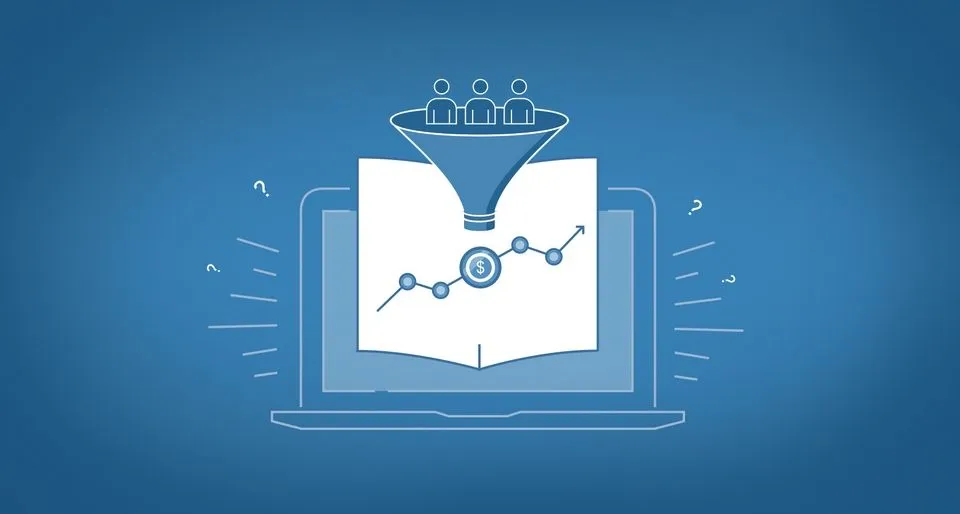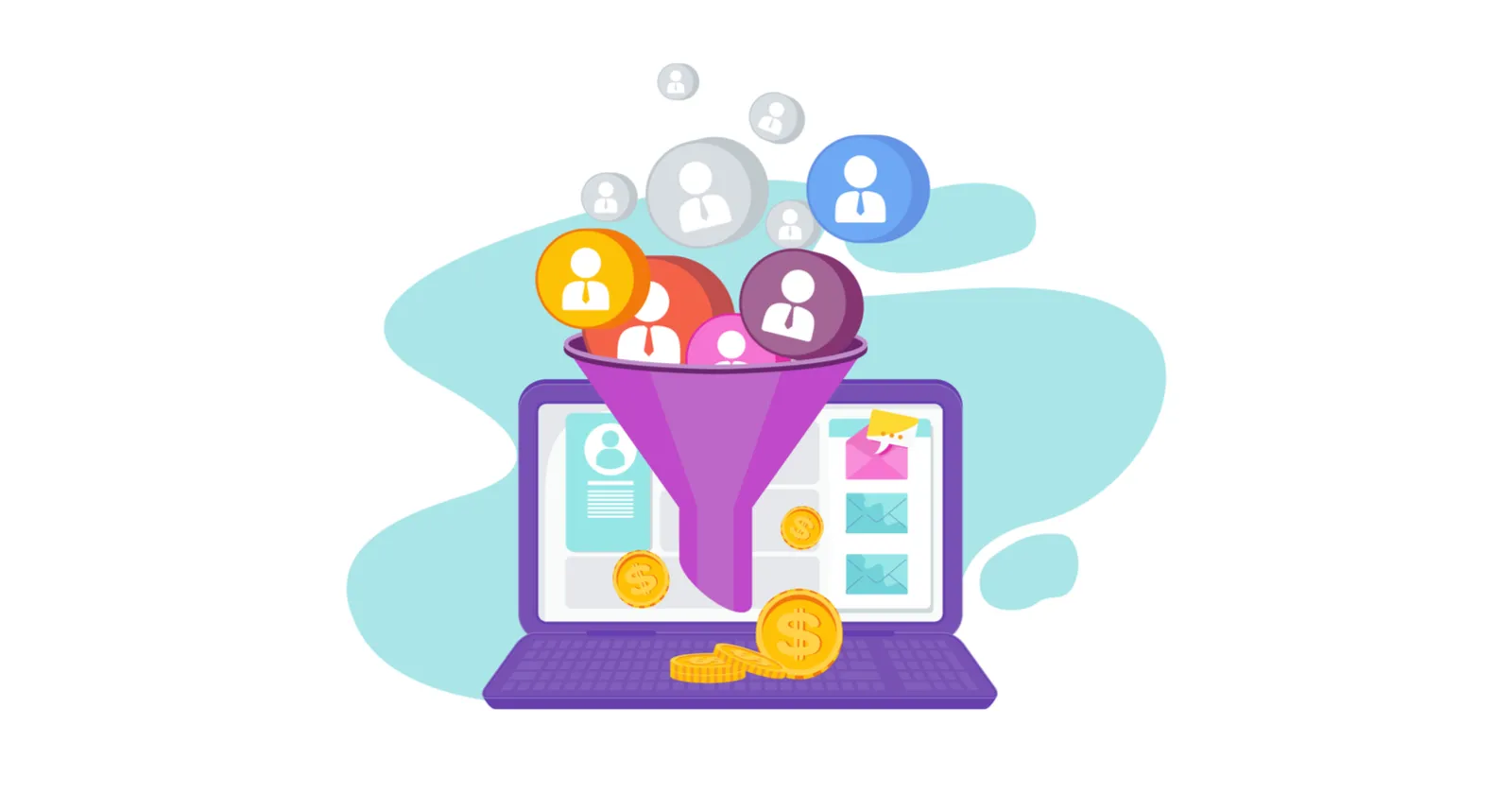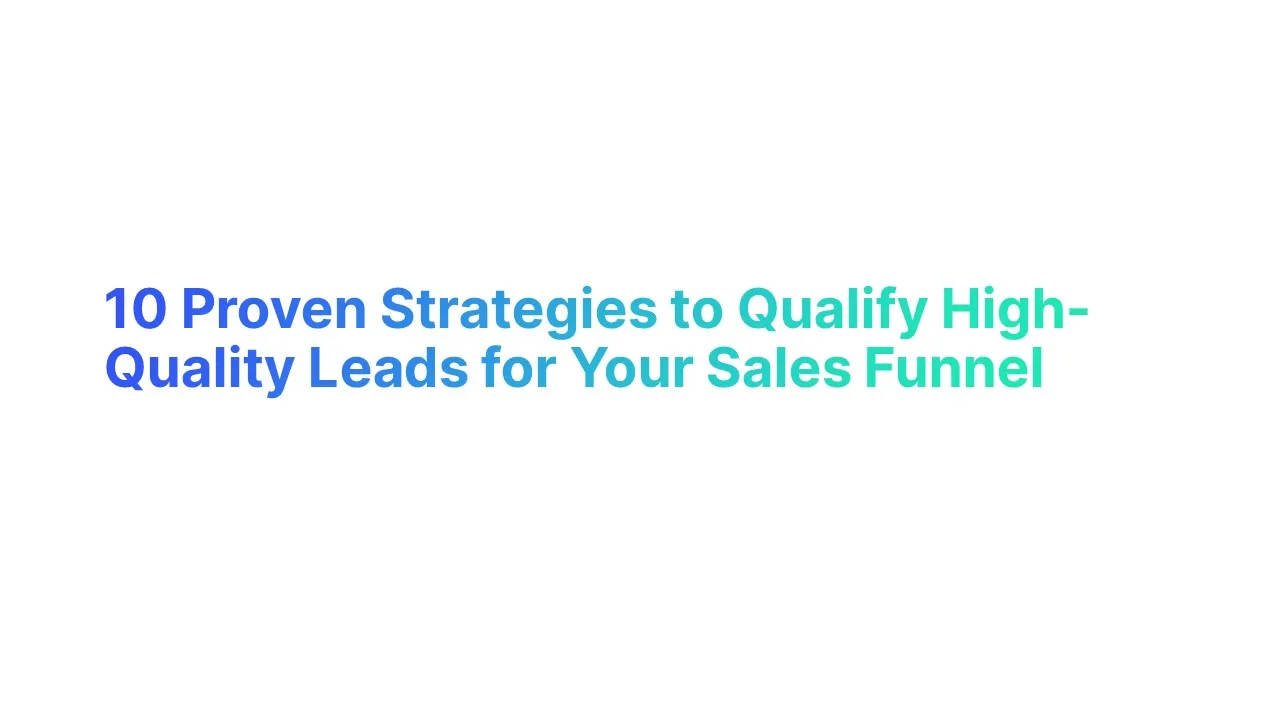Introduction to Quality Leads

What Are Quality Leads? An Overview
Quality leads are potential customers who have a higher likelihood of converting into paying customers due to their interest and fit with your product or service. Typically, these leads have been qualified based on specific criteria that indicate their readiness to purchase, such as their behavior, demographic details, and direct engagement with your brand.
Take, for example, a B2B company that provides cloud storage solutions. By utilizing lead scoring systems and marketing automation tools, the company can identify which leads have interacted with key content like case studies or tech specification sheets. Those engaging more deeply with this detailed information are often considered high-quality leads. This approach allows sales teams to prioritize leads that exhibit a deeper interest and a better fit for their solutions, enhancing the efficiency of the sales funnel.
Your lead qualification models should not be static. They must evolve based on ongoing data analysis and market conditions to capture all potential sales opportunities effectively. For example, reviewing lead conversion rates quarterly can help adjust the scoring criteria to better suit changing market dynamics.
Reasons Why You are Getting Bad Leads

Getting bad leads can be frustrating and costly for any business. Poor lead quality often results from inadequate lead generation processes, misalignment with target audiences, or insufficient lead qualification measures.
Here’s a deeper look into why your strategies might be attracting low-quality leads:
Ineffective Targeting
Targeting the wrong audience or using overly broad parameters can result in leads that do not align well with your product or service offerings. This misalignment generally leads to a lower conversion rate and wasted resources.
Broad Audience Reach: Without a well-defined buyer persona, your marketing campaigns might reach a wide audience but fail to resonate with those likely to convert. A specific, data-driven understanding of your target market is crucial.
Lack of Personalized Content: Failing to create content tailored to specific needs and stages of the buyer’s journey can attract leads who are not ready or suitable for conversion.
Low-Quality Lead Sources
The channels and tactics chosen for lead generation significantly impact lead quality. Relying on sources that do not align with your business goals or audience can fill your funnel with low-quality leads.
Poorly Optimized Ads: Google ads or social media ads that are not optimized with precise targeting criteria can generate high traffic but low conversion. It’s crucial to refine ad placements and targeting based on performance data continuously.
Ineffective Lead Magnets: Lead magnets that do not offer genuine value or relevance to your target audience can attract leads who are interested in freebies rather than serious business engagements.
Insufficient Lead Qualification Processes
A robust lead qualification system helps sift through the leads to find those that are most likely to purchase. Without effective qualification criteria, you risk clogging your sales funnel with unqualified leads.
Lack of Lead Scoring: Without a lead scoring system, it’s challenging to prioritize leads based on their likelihood to buy. Implementing a scoring model based on engagement and demographic data can drastically improve the quality of leads passed to sales.
Inadequate Follow-Up: Quick and effective follow-up actions are essential in qualifying leads. Data shows that leads are 9 times more likely to convert if they are followed up within the first 5 minutes of showing interest.
How to Generate High-Quality Leads

Generating high-quality leads is crucial for any business looking to increase sales and expand its customer base. Here’s a detailed step-by-step guide on how to do so effectively:
Step 1: Define Your Target Audience
Identify Demographics: Determine the age, location, gender, income level, and education of your potential customers.
Understand Psychographics: Know their interests, values, pain points, and buying behavior.
Use Market Research: Conduct surveys, focus groups, and interviews to refine your audience understanding.
Step 2: Create Compelling Content
Educate Your Audience: Produce informative blog posts, ebooks, webinars, and videos that address common questions or problems your target audience faces.
Engage on Social Media: Share content that resonates with your audience and encourages interaction.
Optimize for SEO: Ensure your content is visible in search engine results by targeting relevant keywords.
Step 3: Leverage Multiple Channels
Email Marketing: Send personalized emails to nurture leads by providing valuable content and offers.
Social Media Advertising: Use targeted ads on platforms like Facebook, Instagram, and LinkedIn to reach potential customers.
Networking Events: Attend industry conferences and seminars to connect with potential leads personally.
Step 4: Use Lead Magnets
Offer Freebies: Provide valuable resources like white papers, free trials, or product samples in exchange for contact information.
Webinars and Workshops: Host online sessions that offer insightful content while collecting registration details.
Step 5: Implement a Lead Scoring System
Set Criteria: Assign points based on how closely a lead matches your ideal customer profile and their engagement with your content.
Prioritize Follow-up: Focus your efforts on leads that have the highest scores, indicating a higher likelihood of conversion.
Step 6: Automate Lead Management
CRM Tools: Use customer relationship management software to track interactions and automate follow-ups.
Lead Nurturing Sequences: Develop email sequences that send automated messages based on specific actions taken by leads.
Step 7: Analyze and Refine
Monitor Performance: Use analytics to track which strategies are generating the most leads and conversions.
A/B Testing: Experiment with different aspects of your marketing to see what works best with your target audience.
Feedback Loops: Regularly seek feedback from converted leads to understand what influenced their decision and how the process can be improved.
Step 8: Continuous Learning and Adaptation
Stay Updated: Keep abreast of market trends and emerging technologies that can help improve lead generation.
Training and Development: Invest in training for your team to ensure they are proficient in the latest marketing techniques and tools.
10 Proven Strategies to Qualify Higher Quality Leads

Qualifying high-quality leads is essential for optimizing your sales funnel and ensuring your team focuses on the most promising prospects. Here are ten proven strategies to effectively qualify leads:
1. Implement Lead Scoring
Lead scoring is a quantitative approach to gauging the potential value of leads based on their actions and profile information. It helps prioritize leads that are more likely to convert, thus optimizing the sales team's efforts.
- Set Up Criteria: Define variables such as demographic details, online behavior, engagement level, and specific interactions with your content. For example, downloading a whitepaper might score higher than a simple newsletter sign-up.
- Assign Points: Each action or quality is assigned a point value. For instance, leads from a targeted industry may receive 20 points, while those from a less relevant industry might receive 10.
- Threshold for Sales-Ready Leads: Determine a scoring threshold that a lead must meet before being passed on to sales. A common practice is setting this threshold to capture the top 10-20% of leads, ensuring sales focus on the most promising prospects.
- Continuous Refinement: Regularly update scoring criteria and thresholds based on conversion data. According to Marketo, companies that periodically refine their lead scoring have a 10% better lead conversion rate than those that do not.
2. Use BANT Framework
The BANT framework remains a reliable method for lead qualification, assessing leads based on their Budget, Authority, Need, and Timing. It’s particularly effective in B2B environments where purchase decisions are complex and require clear justification.
- Budget: Confirm if the lead has the financial resources to buy your product. You could start this assessment by asking direct questions about their budget for the project or solution.
- Authority: Ensure the contact person has the decision-making power or influence within their organization. A LinkedIn study found that involving senior leadership in the buying process increases the chance of a sale by 81%.
- Need: Identify if your product or service meets an essential need. This involves understanding their pain points through detailed discussions or assessment forms.
- Timing: Determine if there’s an urgency to their need, which greatly affects their readiness to buy. For instance, a company at the end of its fiscal year might accelerate purchases.
3. Leverage AI and Automation Tools
Artificial intelligence and automation are revolutionizing lead qualification by providing scalable and efficient solutions.
- Predictive Analytics: AI algorithms analyze historical data and user behavior to predict future actions. For example, an AI system can predict lead conversion likelihood with a reported accuracy of up to 85%, according to Salesforce.
- Lead Management Automation: Automate the capture, scoring, and nurturing of leads across multiple channels. Automation ensures no potential lead is overlooked and reduces the human error factor.
- Chatbots and Virtual Assistants: Implement AI-driven chatbots on your website to engage visitors 24/7. They can qualify leads by asking predefined questions and direct high-potential leads to your sales team instantly.
4. Conduct Qualification Surveys
Qualification surveys are a direct and structured way to gather key information from potential leads. By asking the right questions, you can efficiently assess a lead’s needs, budget, and buying timeline.
- Design Targeted Questions: Craft questions that directly relate to the lead’s potential to purchase. This might include inquiries about their current solutions, pain points, and what they are looking for in a product or service.
- Implement at Various Touchpoints: Surveys can be used on your website after a visitor downloads content, during a sign-up process, or even after a webinar. For example, HubSpot uses targeted pop-up surveys on specific blog posts to qualify leads based on the topics they are reading about.
- Analyze Responses for Immediate Insights: Use automated tools to analyze survey responses in real-time, allowing for immediate follow-up actions. Companies using automated survey analysis have seen a 30% reduction in the time taken to qualify leads.
5. Monitor Engagement Levels
Tracking how and when a lead interacts with your content or sales team provides vital clues about their interest and readiness to buy.
- Use Engagement Metrics: Track metrics such as email open rates, click-through rates, website page visits, and time spent on important pages. High engagement in these areas typically indicates a strong interest in your offerings.
- Behavioral Email Automation: Set up automated email campaigns that trigger based on specific behaviors. For example, if a lead visits your pricing page but doesn’t fill out the contact form, they could automatically receive a follow-up email with more information or a special discount offer.
- Segment Leads Based on Activity: Create different follow-up strategies for leads based on their activity level. Highly active leads might get a more direct and urgent follow-up, whereas less active leads may be nurtured with additional information over time.
6. Organize Discovery Calls
Discovery calls are essential for further qualifying leads by opening a dialogue where more nuanced information can be exchanged. These calls allow you to assess the lead’s real intent and fit for your product.
- Prepare Structured Questionnaires: Develop a set of questions that aim to uncover the lead’s business needs, challenges, and objectives. Questions should be open-ended to encourage detailed responses.
- Train Your Team: Ensure that the team handling discovery calls is well-trained not only in product knowledge but also in communication skills. They should be able to listen actively and adapt the conversation based on the lead’s responses.
- Record and Analyze Calls: Use tools to record and review calls for quality and training purposes. Analyzing these calls can help identify common objections and questions, which can be used to refine the sales process. Studies show that companies who consistently analyze discovery calls see a 15-20% increase in conversion rates.
7. Analyze Social Media Behavior
Social media platforms are invaluable for lead generation strategy, providing insights into potential leads' interests and interactions with your brand or industry.
- Monitor Interactions: Track how leads engage with your content to measure lead quality. High engagement levels (likes, shares, comments) often indicate a high-quality lead.
- Listen to Conversations: Use social listening tools to capture mentions of your brand, competitors, or relevant keywords, helping you to generate quality leads.
- Segment Based on Activity: Classify leads based on their social media activity, targeting those who frequently engage with content relevant to your offerings.
8. Look for Referrals
Referrals can generate quality leads because they come pre-vetted by someone who knows both your business and the prospect.
- Encourage Referrals: Implement a referral program that incentivizes current customers to refer new, high-quality leads.
- Track Referral Sources: Maintain detailed records of referrals to understand which sources consistently produce more quality leads.
- Build Relationships: Engage key clients who provide valuable referrals, fostering relationships that encourage ongoing lead generation.
9. Utilize Case Studies and Testimonials
Case studies and testimonials are powerful tools in any lead generation strategy, providing real-world proof of your effectiveness and helping to qualify leads.
- Highlight Success Stories: Use case studies to demonstrate how your product or service has addressed specific challenges, showcasing your ability to handle similar issues for new leads.
- Gather Testimonials: Collect testimonials that reflect the high quality of your offerings and display them prominently to reassure potential leads.
- Tailor Examples: Customize the presentation of case studies and testimonials to align with the specific needs of potential leads, enhancing your strategy to generate more quality leads.
10. Set Up Behavioral Triggers
Behavioral triggers are a crucial component of a sophisticated lead generation strategy, automating responses based on specific lead behaviors.
- Identify Key Behaviors: Define actions that signify buying intent, such as visiting pricing pages or downloading detailed content, to better measure lead quality.
- Implement Automation Tools: Use automation to respond to these behaviors, helping to nurture high-quality leads effectively.
- Refine Over Time: Continuously assess and adjust triggers to ensure they remain effective in qualifying leads and enhancing overall lead quality.
How to Nurture and Convert High-Quality Leads into Paying Customers

Nurturing high-quality leads into paying customers is a strategic process that involves building relationships, providing value, and guiding prospects through the sales funnel.
Here's how you can effectively nurture and convert leads into customers:
1. Understand Your Leads
To improve lead quality, start by gaining a deep understanding of your leads, including their needs, challenges, preferences, and behaviors. This will enable you to tailor your nurturing efforts effectively.
Segment Your Leads: Categorize leads based on factors like industry, role, pain points, and where they are in the buying process. This allows for more personalized communications and helps ensure you're working with qualified leads.
Gather Insights: Use interactions, feedback, and analytics to continuously learn more about your leads’ preferences and behavior, which is crucial in improving lead quality over time.
2. Develop Targeted Content
Content is a powerful tool in nurturing leads. It should educate, engage, and persuade them over time, addressing their specific needs and moving them closer to a purchase.
Educational Content: Provide blog posts, ebooks, whitepapers, and webinars that help solve problems or answer questions your qualified leads may have.
Case Studies and Testimonials: Share success stories and testimonials to build trust and demonstrate the effectiveness of your solutions to qualified leads.
Interactive Content: Use quizzes, assessments, and interactive videos to engage leads actively and collect additional insights about their needs.
3. Leverage Email Marketing
Email remains one of the most effective channels for nurturing leads due to its direct and personalized nature.
Drip Campaigns: Send a series of automated emails that guide leads through the buyer’s journey. Start with educational content and gradually introduce more sales-oriented messages to improve lead quality.
Personalization: Customize emails with the lead’s name, company, and relevant content based on their interests and past behaviors to maintain engagement with qualified leads.
A/B Testing: Continuously test different aspects of your emails, from subject lines to call-to-actions, to optimize open rates and engagement among qualified leads.
4. Utilize Multi-Channel Approach
While email is crucial, integrating other channels can enhance the nurturing process by reaching leads where they are most active.
Social Media: Engage with leads on social platforms through targeted ads, direct messaging, and by sharing relevant content to attract and maintain qualified leads.
Retargeting Ads: Use retargeting to stay top of mind with leads who have visited your website but have not yet made a purchase, helping to improve lead quality.
Direct Contact: Combine digital efforts with more traditional approaches like phone calls or face-to-face meetings when appropriate to further engage qualified leads.
5. Implement Lead Scoring
Lead scoring helps prioritize your efforts by identifying which leads are most likely to convert based on their engagement and behavior.
Define Scoring Criteria: Assign points for various behaviors and interactions, such as downloading content, attending webinars, or visiting key webpages, to help improve lead quality.
Adjust Scores Based on Feedback: As leads progress, update their scores to reflect new interactions and feedback received during the nurturing process, ensuring you focus on the most qualified leads.
6. Focus on Relationship Building
Building a strong relationship with leads can significantly increase the likelihood of conversion.
Regular Follow-ups: Keep in touch with leads regularly to keep your brand top of mind without being intrusive, which is essential for nurturing qualified leads.
Provide Value Continuously: Offer continuous value through insights, tips, and relevant content that helps them in their professional roles, enhancing the quality of leads.
Trust Building: Be transparent, consistent, and reliable in all interactions to build trust over time with qualified leads.
Concluding Thoughts on Enhancing Lead Generation for Quality Leads
Successfully qualifying and nurturing high-quality leads is essential for optimizing your sales funnel and driving business growth. By implementing the strategies discussed—from leveraging sophisticated scoring systems and the BANT framework to engaging in multi-channel nurturing and utilizing AI tools—you can significantly enhance the quality of your leads.
Remember, the key to successful lead qualification and conversion lies in continuously refining your processes based on data-driven insights and feedback. Ensure that every step of your lead management process is geared towards identifying and nurturing potential customers who are most likely to convert, thereby maximizing your ROI and ensuring sustainable business success. Focus on building strong relationships and delivering value at every interaction to convert these qualified leads into loyal customers.





.jpg)

.jpg)
